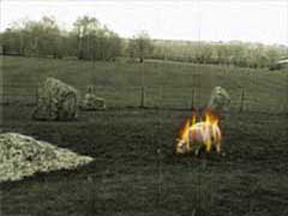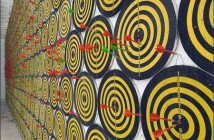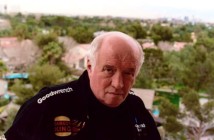MJM: In your essay for the last issue of Big Red and Shiny you use Eve Sussman's video and the Nicholas Berg beheading tape to frame your argument. I'm wondering if you could expand a little bit on the function of the "video frame" and how context can really affect the consumption of a video. A blackened gallery projection and a shaky internet feed offer very different frame works of viewing. Does the "frame" of video override the "frame" of painting or art in general? Or is there more of a driving force behind video's effect that fundamentally changes the consumption of artworks? I guess I'm also hinting at the effect the Sussman video could have on Velazquez, if any.
JH: Clearly, we've had enough experience with television in our culture to have a pretty nuanced approach to viewing video. Interestingly, film really hasn't been able to transcend the theatrical setting, although I've seen some film/installation pieces that use the tropes of video projection within the gallery space. That said, as long as I've been making video (1973-pres.), it has always been plagued by the problem of “time.” Of course, time is of the essence of the medium, and so can't be avoided. It must be shaped to the context of viewing. Bringing the viewer into the “time” of a single-channel, linear work within the gallery frame poses the difficulty of expectations. Time spent on any work in the gallery is usually quite short (I'd say, 5-20 sec.), so the demand of the video for extended time frustrates the viewer. Not good for business. In reaction to this problem, artists have developed other strategies; projected, looped images, durational imagery that doesn't demand a specific time-frame, or multi-monitor installations that activate the space of their relationships. It is in this context that I refer to the Eve Sussman piece (89 Seconds at Alcazar). This work is meant to challenge the primacy of both film and painting by extending its frame into the (darkened) cathedral of high art, and to bring video to its peak performance as the technology of representation. What Velazquez achieved through his deft interlacing of illusions, Sussman transforms into the voyeuristic space of television. No longer are we interested in the imagination of the painting, but now only in the revelations within the representation. This is the simulacrum of the art work. The internet phenomenon is another thing entirely. The Nick Berg tape was buried. I had to search for it. It had been censored in the Media. It was treated as evidence, and suppressed. Images like this are ubiquitous on the Web - lots of little video clips floating around. Most of them, even artists' works, are not seen by everyone (as opposed to the presence of television). They are part of the global interconnection, however, and represent a very diverse population, which now has access to the technology with which to penetrate our cultural space and tweak our nuanced understanding of its message. Suffice it to say that the power of that video was its capacity to use the mechanism of our cultural discourse to show us our vulnerability. What are the consequences to the 'art object'? I don't think the object is going away because there is still the lure of the artist's hand, and the perplexity of decisions that coalesce into its form. But the popular desire, the one framed by TV and all the other technologies of 'connection' does not linger on the artifact with the same satisfaction. The light, the sound, the movement and the dream of technological transcendence are seductive alternatives.
MJM: You seem to hint at the end of your answer that you do not consider video an object. As it becomes more and more collected by museums and private hands, display for works starts to become very important (i.e. the blackened room, more installation like environments, etc.). I'm also thinking about Paul Pfeiffer's work, where the perplexities he uses in his forms materialize from a "digital hand" as well as insisting on certain technological equipment. As video becomes more collectable does it start to become less about a "technological transcendence" and more of a new type of commodity? (hence object?)
JH: I wouldn't say that the 'artist's hand' is not present, especially in digitally manipulated work like Pfeiffer's or my own for that matter. But the materiality of that 'hand' in physical art objects is palpable and affective in ways that fluency with digital applications may not reveal. After all, most software is determinative of approaches to making. The issue of commodification of video-as-object is a compelling one, even though I am still not convinced that video art will ever generate a widespread market. The commitment of space and technological equipment is of an order way beyond that of the work-on-the-wall. When I speak about the dream of technological transcendence, however, I do not exclude the fetishizing of the objects of technology (including the art itself) as 'objects of desire.' 'If you can't have the one you love, love the one you're with.' So, as has been true of film and photography, the medium itself has overshadowed the content (McLuhan said so long ago).
MJM: The artist's "hand" being present or masked by fluency with digital applications is very interesting. It seems it could have a relationship to surrealism in the sense that many of those practitioners wanted to mask the absurd or sublime within naturalistic coding. Do you feel a lot of video comes from that type of tradition? I know your work is related to some surrealistic tendencies, can you expand a bit on the relationship between your practice and the surrealists?
JH: I would say that a lot of video art is still concerned with overt issues of content. This means that the digital manipulations (editing, processing, etc.) are at the service of the message, concept or narrative, and are not often used to transform images into more poetic or symbolic entities. Of course one does see lots of 'compositing' (I'll get into this as I go on), as in advertising and music video as well as in fantasy or sci-fi based films such as The Matrix series or Lord of the Rings.
In the case of my own work, I have always been interested in the ways the technology (both analog and digital) can alter the notion of the frame of the real by bricollaging disparate images to generate new spaces. These spaces are deep, reaching into an intuitive knowing that is both culturally and mythically based. Because of the discontinuities achieved through 'compositing' (I use Adobe AfterEffects combined with some Lightwave 3D), these spaces defy the rules of representation, and suggest an imaginative reading of the contents. I cannot say that I have a particular affinity with the surrealists, except that they were interested in breaking through the appearance of things into their psychological relationships. Because I am dealing with the 'ether' as a medium (an odd old term that I associate with the ephemerality of the 'signal'), I tend to lean toward a more philosophical modeling. Mine is an abstract space (I often place my imagery in a black space) which lends itself to phenomena that are concerned with the structure of systems, ontologically speaking. At least, I hope to address the nature of being through these metaphors.
MJM: Can you elaborate a bit on the "ephemerality of the signal?" Does this relate to a kind of fleeting from the "real" (in Lacanian terms)? Can you also describe the newer works that were on display at Stephen Stux Gallery in NYC or the videos that were shot in England in relation to this concept?
JH: By the 'ephemerality of the signal' I mean more an entry into the 'real' as that which is filled with multiplicities, variances, emergences, potentialities, and not that which 'appears' to exist. Video is nothing but an electronic matrix, a dip into the unformed which through the structure of digital systems can become 'something'. This something is always ultimately that which appears, but is fleeting. It is made of the 'stuff' that is all around us, in us, at all times (video snow is an echo of the 'big bang', some say). Of course, the consequence of this forming that comes through the technology, may, in fact, serve as a 'fleeing' from the complexities of life, but may also dip into those complexities for insight. Three works were shown at Stux: "Tale", 2001, which is one of the England pieces, "System", 2003, a 3D piece, and "Vegas", 2004, a somewhat 'painterly' exploration of flux. In the works from England, I was interested in using the technology to explore the ways in which our memories, both personal and collective, are mirrored in the look of film. The images are processed to look like old b/w film, and reflect a nostalgia for the pastoral. I am equating that longing with the 'indexical' tropes of film, and the problematic of its loss in the framing of Nature by science and technology. In "System", I have created a model of a simple gravitational relationship, four flying bodies orbit around a central figure within abstract black space. In this instance, the objects on view are entirely virtual, verging on something like planetary behaviors, but freed from the notion of a specific space and time. This again is a model for behaviors in general. I'm dipping into the 'signal' to locate an archetype. Finally, "Vegas" comes directly out of my reading of Deleuze (esp. The Rhizome and his work 'On Bergson'). Using a landscape shot as a drive-by (look at that language! Something violent in it) and processing it so that the time is looped in chaotic shifts, and the image is dematerialized into moving color shards. Occasionally, remnants of the 'frame-of-landscape' float through the larger frame, but seem reluctant to verify the expected pictorial referent. In this flux, there may be a hint of the underlying structure of time and appearance, but the ground keeps slipping away.
MJM: I'm interested in what appears as a contradiction. In using the "ephemerality of the signal" while at the same time trying to find an "archetype in the signal." Would this be an archetype based on instability or multiplicities? Is this possible, or is this more or less the state of things? Changing the topic a bit... In recent years there seems to be many more historical surveys of video. I'm wondering how you think this history is being written and how accurate or compelling it is for you, considering how ephemeral the medium is and that you were around when many of the "original" practitioners were making work.
JH: Well, I understand your confusion. Within the 'signal' one can find (with imagination) potentialities that are linked to personal and/or collective images, memories, ideas. After all, video is an image medium even though its essence is electronic. So, I look for 'archetypes' that float in the media sphere, the arena of representation. I am looking based on some philosophical as well as visual models, seeking to construct meanings that clarify/challenge those models as well as exploit the possibilities within the machine (as site of the signal). I don't attempt to resolve the contradiction. As to the 'history of video', a few years ago I started using the text, "Illuminating Video" (ed. Doug Hall and Sally Jo Fifer, Aperture in Association with the Bay Area Video Coalition) for a video seminar I was teaching. This text attempts to organize video production into a series of compartments or categories, e.g. histories, furniture/sculpture/architecture, audience/reception: access/control, syntax and genre, telling stories. It does so with care and concern for the position of the medium as an aesthetic tool as well as a social engine. And, as with all histories, it is written in hindsight and with an editorial agenda (I will not comment on those biases). As someone who has been working with the medium from its early days (I participated in the WGBH New Television Workshop in the '70's), my experience was one of genuine multiplicities, experiments, shots in the dark. Television was the main model, and so much of the work done then used TV models to critique the cultural status quo (Wegman, Paik, Jonas, Campus, Benglis, Rosler, to name just a few of the notables). With the development of more accessible and less arcane technology, artists and activists brought video into the mainstream of the cultural discourse. By now, the medium has achieved ubiquity in all quarters, and has achieved the status of 'high art', as we all know. It is a natural consequence of this growth that critics and historians would try to make sense of the 'movement' for the sake of those who weren't there from the beginning. But, I have to say that these attempts have little to do with the profusion that characterized the explosion of the medium onto the scene. It is true in general that 'looking back' freezes the flow of productions into distinct categories which are more about the mindset of the era in which they are written than the truth of the chaotic present in which they were made. The medium spoke to all kinds of needs and was exciting for its revolutionary potential as an art as well as a 'voice' for those who had been silenced in the mainstream. As of now, video has developed canons of production, presentation, and reception. We know how to look at it, and this knowing is based on a codification within educational and critical institutions.
MJM: Any advice for emerging artists just starting their career?
JH: Oy weh! I can't begin to say what works for everyone. Each artist has a particular path. If one wants to teach, the Masters degree is bottom line. And even for professional progress, the degree provides a necessary perspective. I am one of a passing generation of artist/teachers who came to the job through practice. In any event, one does have to follow the work, give faith to the process and devotion to its results. Read a lot, see a lot, live a lot.
All images courtesy of Jane Hudson.
Micah Malone is a regular contributor to Big, Red & Shiny.
Jane Hudson is a contributor to Big, Red & Shiny, as well as an artist, educator, musician and critic.




